Video reveals baby steps of newly hatched ‘walking’ sharks
This unique strategy may help the sharks survive strandings in tide pools.

Some sharks can "walk," and researchers recently discovered how one of these unusual shark species practice taking baby steps. They begin when they're newly hatched, and a hatchling's walk is no different from that of older juveniles.
When the tide near a coral reef goes out, a small species of carpet shark is often left behind. When stranded in shallow tide pools with dwindling oxygen levels and rising temperatures — or worse, beached on hot slabs of exposed reef — most aquatic species wouldn't stand a chance. But the epaulette shark (Hemiscyllium ocellatum) can hold its breath for hours and tolerate a range of temperatures. And in a pinch, it can walk.
"At low tide, when the reef is exposed, you can see them out there walking on the reef," said Marianne E. Porter, an associate professor at Florida Atlantic University who studies the mechanical structures and motion of sharks. She told Live Science that these hardy little sharks can walk on land and underwater, flopping across substrate on four paddle-shaped fins for more than 90 feet (27 meters) until they find a suitable nook where they can wait out the tide.
It's one of nature's most distinctive survival strategies, but few studies have examined the physics behind epaulette shark locomotion and gait. Now, a new study in the journal Integrative and Comparative Biology is the first to describe the mechanics of how newly hatched epaulette sharks walk.
The findings may ultimately help scientists understand how other aquatic species will tolerate climate change-related stresses, such as rising carbon dioxide levels.
"Epaulette sharks live at the extremes," said Porter, lead author of the study. "If we want to learn what happens to animals under the extreme conditions of climate change, looking at animals already living under these conditions — and understanding how they move and cope — may be the first step."
Related: 'Walking sharks' caught on video, astound scientists
Sign up for the Live Science daily newsletter now
Get the world’s most fascinating discoveries delivered straight to your inbox.
Bloated baby sharks
Both Porter and study co-author Jodie Rummer, a professor of marine biology at James Cook University in Australia, had been studying epaulette sharks for years, but they were frustrated to discover that very little information existed on how the carpet sharks actually walk. The most recent study to examine epaulette shark locomotion was published in the late 1990s and focused exclusively on mature sharks. The question of how juvenile and baby sharks walk had never been addressed in the scientific literature.
Porter and Rummer suspected that baby sharks would walk differently than older juveniles and adults did. Epaulette sharks are born bloated, their bellies distended by a yolk sac that fulfills all of their nutritional needs for about one month until they are mature enough to feed on small fish and worms. Their baby fat then rolls off, giving way to the familiar spindle shape of an adult shark.
"Shape generally impacts the way we move," Porter said. "Human babies walk differently to balance their giant heads, and we assumed that baby sharks would wiggle their bodies and move their fins differently to accommodate their giant bellies."
But after examining multiple videos of young sharks walking and swimming, the researchers were surprised to discover that all young sharks, from newly hatched babies to juveniles that were free of the yolk sacs, appeared to move in the same manner. This observation held across several key metrics, including speed, frequency of tail beating, body bending and fin rotation.
"I really thought baby sharks would move differently," Porter said. "But in science, we take our best guesses based on the available evidence, and our hypothesis turned out to be wrong."
Beyond walking sharks
It is unclear why baby sharks don't adopt gaits better suited to their bulbous bellies. One possible explanation is that gravity plays a role. The recent study only examined sharks walking underwater, where the yolk sac's bulk does little to hinder movement. In future studies, Porter hopes to look at whether baby sharks adjust their gaits on land to account for the extra weight.
Further research into epaulette shark locomotion also may be useful for evolutionary biologists who study how animals transitioned from water to land, as well as biomechanics researchers who, like Porter, study how fins and feet interact with surfaces and how animals account for gravity and body shape when moving through different environments.
Meanwhile, epaulette sharks are emerging as models for scientists who study how marine fish adapt to changing oceans. Studying how these unique sharks walk to safety may ultimately lead to a better understanding of how other species move within — and away from — challenging environmental conditions, including those associated with climate change.
"From an evolutionary perspective, a climate change perspective and even a basic physiological perspective, there's a lot we can learn from epaulette sharks," Porter said.
Originally published on Live Science.

Joshua A. Krisch is a freelance science writer. He is particularly interested in biology and biomedical sciences, but he has covered technology, environmental issues, space, mathematics, and health policy, and he is interested in anything that could plausibly be defined as science. Joshua studied biology at Yeshiva University, and later completed graduate work in health sciences at Cornell University and science journalism at New York University.










